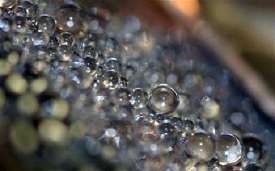Aug 15 2008
The development of a transparent coating that causes water to bead up into drops and roll or bounce off a surface will help protect and sustain Air Force systems by preventing corrosion and reducing ice formation on optical elements and aircraft.
 This image shows how a transparent coating causes water to bead up into drops and roll or bounce off a surface. This new technology will help protect and sustain Air Force systems by preventing corrosion and reducing ice formation on optical elements and aircraft.
This image shows how a transparent coating causes water to bead up into drops and roll or bounce off a surface. This new technology will help protect and sustain Air Force systems by preventing corrosion and reducing ice formation on optical elements and aircraft.
An Air Force Office of Scientific Research-funded team, led by Dr. C.J. Brinker, has developed the transparent coating
In addition to keeping water away, the researchers also are using this technology to design a patterned surface that combines extremely water-repellent and water-absorbent areas to draw water out of humid air. This application -- modeled after the Namib Desert beetle -- could provide a new method for collecting water without the use of energy and could benefit troops in areas where water is scarce.
In order to produce and apply a coating with superhydrophobic, or extremely water-repellent, properties, the Brinker Nanostructures Research Group at the University of New Mexico and Sandia National Laboratories had to control coating roughness and surface chemistry on a small scale.
The team, already known for their breakthroughs in aerogel thin film processing, drew from that research to develop a simple method for depositing the coating on every contour of a surface by spraying, spinning or dipping.
Doctor Brinker explained that by a simple modification of a chemical precursor, the team reversed the shrinkage that typically occurs as a coating dries. Instead, it springs back, creating a nanoporous surface with super water-repellant properties.
"The most recent advancement in this research is the ability to selectively pattern the coating and spatially control the wetting behavior for a desired application," Doctor Brinker said. "This allows us to define the pathways along which water droplets will roll."
Their recent work has opened the door to new applications that exploit the way the coated surface interacts with liquid droplets. When water droplets roll along the coated surface, they pick up debris as they go. Doctor Brinker explained that this property might make the collection, concentration and identification of aerosol borne particles like anthrax possible.
The research is also likely to transition to commercial applications such as protection of electronics and antiquities from water damage.
For more information on corrosion, click here.